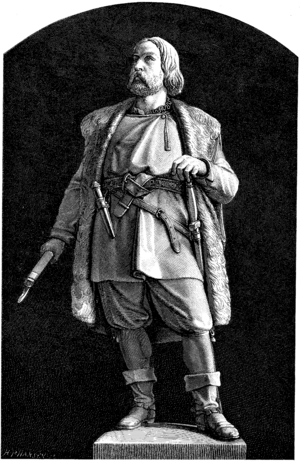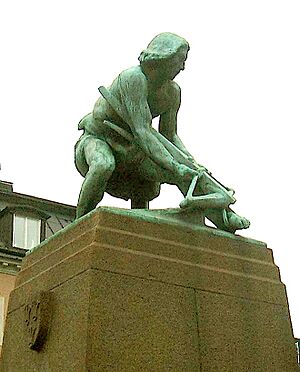Engelbrekt Engelbrektsson facts for kids


Engelbrekt Engelbrektsson (born in the 1390s – died April 27 or May 4, 1436) was a Swedish nobleman and a brave leader. He led a big uprising called the Engelbrekt rebellion in 1434. This rebellion was against Eric of Pomerania, who was the king of the Kalmar Union. Two important places, Engelbrekt Parish and Engelbrekt Church in Stockholm, are named after him.
Contents
Engelbrekt's Life and the Rebellion
Engelbrekt Engelbrektsson owned a mine and an ironworks in a historic mining area called Bergslagen. His family came from Germany in the 1360s. Their family symbol showed three half-lilies shaped like a triangle.
Engelbrekt and many others were unhappy with the Danish local officials, called bailiffs. These officials were often unfair and collected very high taxes. In 1434, Engelbrekt started a rebellion with the help of miners and farmers from his home area.
People were especially upset with the king's bailiff in Västerås, Jösse Eriksson. He made life very hard for the miners. Engelbrekt complained to King Erik of Pomerania, and the king found that Jösse's actions were wrong. But Jösse was not removed from his job.
This made the people even angrier. A large group of farmers went to Västerås to protest. Even though a group of important Swedish leaders, called the Riksråd, tried to help, nothing was done about the bailiff.
In the spring of 1433, the protests became violent. People from Dalecarlia surrounded the bailiff's castle. The Riksråd finally fired Jösse and replaced him. But Engelbrekt was still not happy because Jösse had not been punished for his crimes.
Soon, people from Dalecarlia and Västmanland destroyed two castles. At this point, many nobles joined the rebels. The rebellion grew very quickly and spread across the country. This uprising happened because people were unhappy with the Kalmar Union, which joined Sweden, Denmark, and Norway under one king.
In 1435, Engelbrekt was chosen as the Commander in Chief, or Rikshövitsman, at a big meeting called a Riksdag in Arboga. This meeting is often seen as the first Swedish Riksdag. However, the Swedish nobles wanted to use the rebellion for their own power. Engelbrekt was slowly pushed aside.
The nobles and church leaders decided to support Karl Knutsson Bonde. In 1436, Karl Knutsson Bonde took Engelbrekt's place as Commander in Chief. Jösse Eriksson, the old bailiff, returned to Sweden that same year. But he was caught by peasants in Motala and punished by them.
On May 4, 1436, Engelbrekt was killed on a small island in Lake Hjälmaren. He was murdered by an aristocrat named Måns Bengtsson, who lived nearby. Måns's father had a disagreement with Engelbrekt about a ship that was burned. Some historians believe Engelbrekt's killing was a planned murder. Engelbrekt was buried in Saint Nicholas Church in Örebro.
Måns Bengtsson was a Swedish knight and a chief judge. He belonged to a noble family called Natt och Dag.
What Happened After
After his death, Engelbrekt became a national hero in Sweden. People saw him as a protector of the public and someone who fought against the Kalmar Union. His rebellion was seen as the start of Sweden becoming its own strong nation. This idea became very important later, especially with King Gustav Vasa (who ruled from 1523 to 1560).
Engelbrekt himself probably didn't plan for Sweden to become fully independent. But his rebellion gave ordinary people, like farmers, a voice in Swedish politics. They kept this voice even after the rebellion. The Engelbrekt rebellion weakened the Kalmar Union and led to Danish forces leaving Sweden. Even though Danish kings later gained some power in Sweden again, Engelbrekt's rebellion showed that Swedes wanted to be in charge of their own country.
Engelbrekt's Legacy
- A bronze statue of Engelbrekt was put up in Örebro in 1865. It was made by a Swedish artist named Carl Gustaf Qvarnström.
- There is another statue of Engelbrekt on top of a pillar outside Stockholm City Hall.
- Carl Georg Starbäck wrote a novel about Engelbrekt called Engelbrekt Engelbrektsson in 1868–69.
- Gustaf Wilhelm Gumælius wrote a poem about Engelbrekt in 1858.
- August Strindberg included Engelbrekt in his play Saga of the Folkungs in 1899.
- Engelbrekt was also the subject of an opera (a musical play) called Engelbrekt in 1928. It was created by the Swedish composer Natanael Berg.
See also
 In Spanish: Engelbrekt Engelbrektsson para niños
In Spanish: Engelbrekt Engelbrektsson para niños
Images for kids




